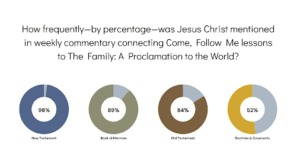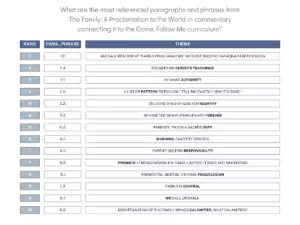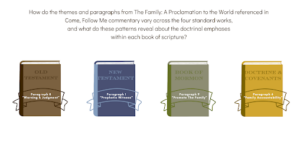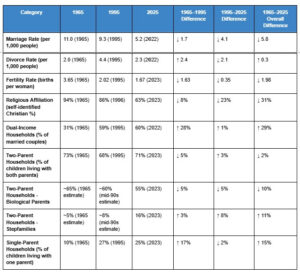 Download Print-Friendly Version
Download Print-Friendly Version
When President Hinckley announced The Family: A Proclamation to the World in 1995, I didn’t think much about it. I was in the early stages of raising a young family, and much of the Proclamation felt straightforward. The prophetic warnings didn’t seem to apply to the world as I knew it then. I didn’t see it for the safety and clarity it would provide.
Things have changed. The basic values expressed in the Family Proclamation are not only widely ignored, but they are actively criticized. I have had loved ones leave The Church of Jesus Christ of Latter-day Saints because (in their view) the Church was insufficiently loving or Christian in its teachings about marriage, family, sexuality, and gender.
Several years ago, I desired to better understand how the doctrine and principles of the Family Proclamation fit in with the broader gospel of Jesus Christ. Beginning in 2020, I made a quiet commitment to study family doctrine through the scriptures. What began as a simple desire for clarity became a four-year journey through all four standard works.
What I confirmed is that despite the many cultural, societal, and structural shifts of our time, the doctrine of the family remains constant, woven throughout every generation. It stands at the center of God’s eternal plan: for me, for my family, for all of His children.
What the Research Shows
That personal journey became a project called Finding the Family in Come, Follow Me. Each week, I (and sometimes a friend or family member) studied a section of scripture following the study schedule in Come, Follow Me. That section of scripture was searched for mentions of doctrines or principles also taught in The Family Proclamation. After study, a brief analysis of approximately 400-450 words was written of the correlating doctrines between that week’s study of scripture and The Family Proclamation. What began as a simple desire for clarity became a four-year journey through all four standard works.
After completing a four-year cycle through the four standard works, I undertook a longitudinal content analysis to identify themes or patterns. By analyzing what was written, additional insights relating doctrines in the Family Proclamation to the rest of the gospel could be found. Critics might claim the results were “gamed” by including certain words or topics in each week’s analysis. However, the project was conducted without any agenda beyond trying to understand how the Family Proclamation and the scriptures relate to one another. At its core, the guiding question was simple: if family is central to God’s plan, shouldn’t its doctrines be found every week, in every set of scripture? The results shared here are drawn solely from the Finding the Family in Come, Follow Me project, but the patterns and themes found may be useful to others seeking to better understand the family within the gospel.
What follows is a summary of the patterns discovered: evidence of a living doctrine of the family.
Jesus Christ at the Center
It would be best to start with Jesus. How frequently was Jesus Christ mentioned in Finding the Family in Come, Follow Me? Mentions of Jesus Christ include references such as God, Lord, Jesus, Christ, or Savior—across all weekly reflections. The resulting percentage indicates the frequency with which He was named.

In over half, and in some cases nearly all, of the scriptural connections drawn between the reflections and The Family: A Proclamation to the World, Jesus Christ appears. One reflection, for example, drew on His tender imagery: “as a hen gathereth her chickens under her wings”— pointing out that Christ’s desire is not to leave anyone behind, but to gather all who will come to Him under His protection. In the family, God has given His children a similar pattern for nurturing, protection, and safety.
The doctrine of the family is centered in Christ. The Living Christ, issued five years after The Family: A Proclamation to the World, declares that “He taught the truths of eternity, the reality of our premortal existence, the purpose of our life on earth, and the potential for the sons and daughters of God in the life to come.” His Resurrection and promised eternal life are not only central to His mission, but they are central to the family. Families don’t work without Him. As one reflection on Moroni’s final invitation expressed, “Not because families are perfect; it’s because families are worth it.” Families are worth it because they are eternal; they are the structure God designed for His children to grow, learn, and prepare for this life and what lies beyond.
Paragraphs That Stood Out Most
Which paragraphs and phrases from The Family: A Proclamation to the World were mentioned most often in Finding the Family in Come, Follow Me? This question guided the next stage of analysis. When reviewing the data began, it was expected that the most frequently cited parts of The Proclamation would be the same paragraphs that draw the most debate in the world today: those dealing with procreation, sexual intimacy, and the sanctity of life. Yet in a world so fixated on precisely these issues, they were not most commonly cited. Why? Not because families are perfect; but because they’re worth it.
This raised the question: which paragraphs were most often mentioned? The findings are presented here in ranked order, with ties indicated.

Several reflections illustrate this point. One drew on the imagery of the armor of God, noting that protection does not come from a single piece of armor but from the strength of the whole. A family is designed as that natural “whole.” There are principles that help the family and its members to act as such. Paragraph 7 of the proclamation lists principles that safeguard families—faith, service, health, reverence, and wise use of time. Woven together, these elements fortify our homes just as spiritual armor fortifies the soul. Debate and demands speak loudly, but the Spirit points to what matters most.
A third reflection compared the proclamation to Noah’s ark, given before the storm but containing within it the means of safety. Paragraph by paragraph, it outlines principles—marriage, gender, chastity, children, duty, advocacy—that parallel today’s most pressing issues. God invited Noah and his household into the ark and shut them in for safety. In the same way, Latter-day Saints are invited to live within the principles of The Proclamation, finding protection in Christ when the storms of culture rage.
Other reflections focused on the role of prophets as special witnesses. In 1995, fifteen apostles and prophets signed their names to this united declaration. In a day when many marvel at shifting cultural standards, their testimony anchors us to Christ’s doctrine of eternal families. As the Lord Himself declared, “whether by mine own voice or by the voice of my servants, it is the same” (D&C 1:38).
Taken together, these reflections show why the most frequently cited paragraphs were not the ones the world debates most. The Spirit directs us away from distraction and back to what matters most: God as the author, the family as eternal, prophets as His witnesses, and the structure and duty found within the family.
There is something deeply moving about seeing a long-held testimony of these truths confirmed in the patterns and evidence. The doctrine is clear. The relationships are real. All mankind is family. There are no misfits. And though unanswered questions linger, the doctrine of belonging is just as true, fitting beautifully alongside the doctrine of the family.
Themes Across the Scriptures
Which themes and paragraphs from The Family: A Proclamation to the World stood out most in the different standard works? Each book of scripture brought its own emphasis, lifting a particular theme into focus. The graphic below shows which paragraphs and themes stood out in each case, setting the stage for a single striking point of unity.
Old Testament – Paragraph 8: “Warning & Judgment”
The most frequently cited paragraph in the Old Testament analysis was paragraph 8 of the Proclamation, which issued a warning of divine accountability for those who violate covenants, abuse family members, or neglect family responsibilities. This theme of “Warning & Judgment” aligns closely with the Old Testament’s prophetic voice, which often calls individuals and nations to repentance and outlines the consequences of disobedience. The Old Testament’s voice of warning aligns closely with The Proclamation’s call to moral accountability.
New Testament – Paragraph 1: “Prophetic Witness”
For the New Testament, the most frequently cited portion of The Proclamation was its opening declaration: “We, the First Presidency and the Council of the Twelve Apostles …” This phrase serves as a Prophetic Witness—a formal, unified testimony from living apostles. The connection to the New Testament is particularly fitting, as that volume of scripture is centered on the authority, testimony, and teachings of Christ’s mission and His original apostles. Its frequent use in the New Testament analysis underscores that Christ’s authority continues through His latter-day prophets and apostles today.
Book of Mormon – Paragraph 9: “Promote the Family”
The Book of Mormon most frequently relates to paragraph 9, which calls upon citizens and government leaders to uphold and promote the family as the foundational unit of society. The theme “Promote the Family” reflects the Book of Mormon’s strong emphasis on agency, righteous leadership, and covenant community. Just as prophets like King Benjamin and Alma called upon their people to build a society grounded in gospel principles, this paragraph echoes that call to action in a modern civic context. Its prominence emphasizes the covenantal foundation upon which righteous societies and lasting happiness are built.
Doctrine and Covenants – Paragraph 6: “Family Accountability”
The Doctrine and Covenants (D&C) provides a distinctly restored lens. The sacred duty of parents and the promise of eternal family relationships are woven through the Restoration’s most defining revelations.
In the Doctrine and Covenants, the most frequently related paragraph was paragraph 6, which outlines the solemn responsibility of husbands and wives to love and care for one another and their children. The theme “Family Accountability” reflects the Restoration’s unique focus on priesthood stewardship, eternal covenants, and divine order regarding the doctrine of the family. The prominence of this paragraph highlights the D&C’s emphasis on spiritual and practical duties that govern the sacred relationships within family life. Accountability before God begins at home. Accountability before God begins at home.
The most frequently related phrases from The Family: A Proclamation to the World, as they appear in the analyses across the four standard works, reveal a clear and complementary harmony in the way family doctrine is reinforced throughout scripture. Taken together, the top ten references show consistent alignment with the core teachings of The Proclamation. However, when examined individually, each book of scripture’s analysis tends to emphasize different paragraphs. In fact, some books’ analyses do not reference certain paragraphs at all, while in every case, one paragraph stood out as the most emphasized within that particular volume. This variation suggests that while the doctrine of the family is unified across dispensations, each scriptural book offers a distinct lens highlighting specific aspects of The Proclamation’s message.
Notably, only one striking point of unity comes into focus across the analyses from all four volumes of scripture: the opening line of paragraph one,
“We, the First Presidency and the Council of the Twelve Apostles of The Church of Jesus Christ of Latter-day Saints.”
This could be procedural, even institutional, at first glance, but its widespread presence suggests an alternative conclusion. Of 32 phrases, the prominence of this one as the singular phrase across every scriptural volume is striking. It is not a doctrinal statement per se, but a declaration of prophetic authorship and unified apostolic voice. Across ancient and modern texts, the voice of prophetic authority carries weight. The phrase repetition suggests that Come, Follow Me curriculum authors likely recognize the Proclamation’s authority as foundational to the teachings that follow. Prophets define, defend, and declare family doctrine throughout time. Their witness is not confined to one generation or volume of scripture; it is echoed and sustained in every dispensation.
Family Doctrine: Then and Now
This research project coincides with the 30th anniversary of The Family: A Proclamation to the World—a milestone that was unplanned for, but has come to be appreciated. The timing caused reflection on the generations surrounding the publication of The Family Proclamation. What follows is an examination of compelling aspects of family life, then and now: 30 years before and 30 years since The Proclamation was published. Prophets define, defend, and declare.

Research shows that the traditional structure of the family has experienced significant strain in recent decades. Marriage rates have declined sharply, with the steepest drop between 1995 and 2025. Divorce more than doubled from 1965 to 1995 before stabilizing. Fertility has fallen steadily, now below the replacement level. Dual-income households more than doubled between 1965 and 1995 and have remained high since, reflecting both economic necessity and shifting gender norms. Two-parent households declined overall, with a small increase between 1995 and 2025. Yet fewer children now live with both biological parents, as stepfamilies and single-parent homes have become more common.
The most dramatic shift has been in religious affiliation. Christianity declined from 94 percent to 63 percent of the population, a major generational change. Although faith and family are often studied separately, the two are closely connected. Declining religious identity is correlated with rising rates of crime, depression, homelessness, loneliness, and addiction. These are not just statistics but lived realities with far-reaching consequences. They are the very calamities foretold by ancient and modern prophets.
The Family: Then, Now, and Always
Thirty years ago, The Family: A Proclamation to the World entered our collective conversation. Today, its voice feels louder and more urgent. The words have not changed, but the world around them has. What once felt like simple guidance now reads as prophetic vision: it is neither ancillary nor outdated. Striving for the ideal fixes our desires on eternal hope.
If the family is this central to God’s plan across all scripture, then it deserves to be this central in our lives. However, in a time when family structures are strained and societal norms shift quickly, few would likely consider their family situation ideal. Because no one individual is perfect, no family can be. But striving for the ideal fixes our desires on eternal hope.
The invitation might layer immediate pressure to fix everything at once, but if we begin with desire and let the doctrine of the family settle more deeply into our hearts and habits, the opportunity is to keep learning, to keep returning to scripture, and to trust that God will guide us as we seek to live in harmony with His plan. We can reflect on this deeply personal question:
What one step can I take to better honor and nurture the divine design of family in my own life?
What the Proclamation declared in 1995 remains true today. The family is central to the Creator’s plan for the eternal destiny of His children. That was true then. It is true now. And it always will be.
The post The Family in Scripture: A Four-Year Study, One Central Truth appeared first on Public Square Magazine.
Continue reading at the original source →



